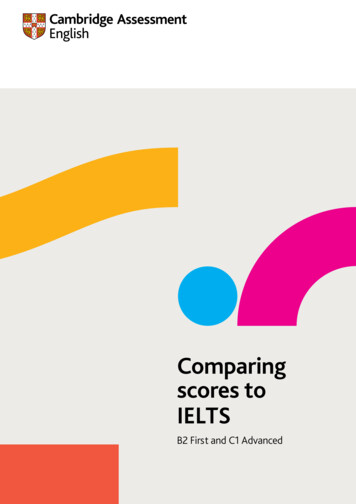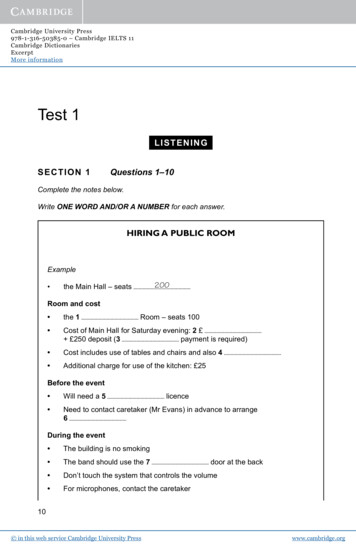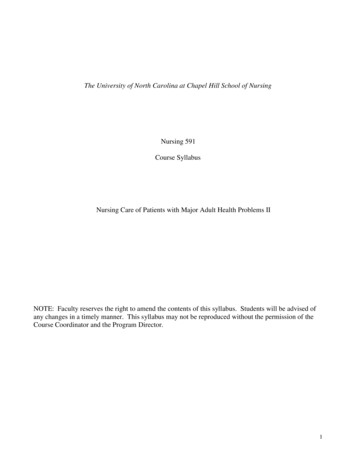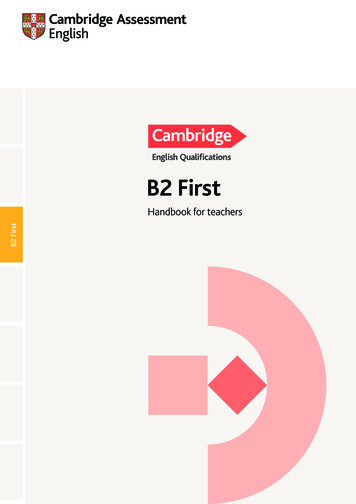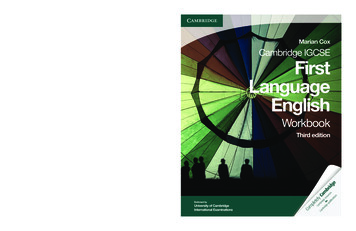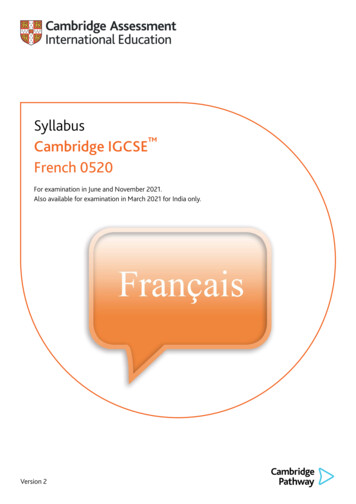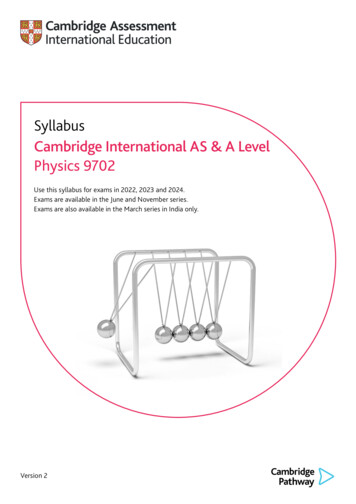
Transcription
SyllabusCambridge International AS & A LevelPhysics 9702Use this syllabus for exams in 2022, 2023 and 2024.Exams are available in the June and November series.Exams are also available in the March series in India only.Version 2
Why choose Cambridge International?Cambridge International prepares school students for life, helping them develop an informed curiosity and a lastingpassion for learning. We are part of the University of Cambridge.Our Cambridge Pathway gives students a clear path for educational success from age 5 to 19. Schools can shapethe curriculum around how they want students to learn – with a wide range of subjects and flexible ways to offerthem. It helps students discover new abilities and a wider world, and gives them the skills they need for life, so theycan achieve at school, university and work.Our programmes and qualifications set the global standard for international education. They are created by subjectexperts, rooted in academic rigour and reflect the latest educational research. They provide a strong platform forstudents to progress from one stage to the next, and are well supported by teaching and learning resources.We review all our syllabuses regularly, so they reflect the latest research evidence and professional teachingpractice – and take account of the different national contexts in which they are taught.We consult with teachers to help us design each syllabus around the needs of their learners. Consulting withleading universities has helped us make sure our syllabuses encourage students to master the key concepts in thesubject and develop the skills necessary for success in higher education.Our mission is to provide educational benefit through provision of international programmes and qualifications forschool education and to be the world leader in this field. Together with schools, we develop Cambridge learnerswho are confident, responsible, reflective, innovative and engaged – equipped for success in the modern world.Every year, nearly a million Cambridge students from 10 000 schools in 160 countries prepare for their future withthe Cambridge Pathway.‘We think the Cambridge curriculum is superb preparation for university.’Christoph Guttentag, Dean of Undergraduate Admissions, Duke University, USAQuality managementCambridge International is committed to providing exceptional quality. In line with this commitment, ourquality management system for the provision of international qualifications and education programmes forstudents aged 5 to 19 is independently certified as meeting the internationally recognised standard,ISO 9001:2015. Learn more at www.cambridgeinternational.org/ISO9001Copyright UCLES September 2019Cambridge Assessment International Education is part of the Cambridge Assessment Group. Cambridge Assessment is the brand name ofthe University of Cambridge Local Examinations Syndicate (UCLES), which itself is a department of the University of Cambridge.UCLES retains the copyright on all its publications. Registered centres are permitted to copy material from this booklet for their owninternal use. However, we cannot give permission to centres to photocopy any material that is acknowledged to a third party even forinternal use within a centre.
Contents1 Why choose this syllabus? .32 Syllabus overview .7Aims7Content overview8Assessment overview9Assessment objectives113 Subject content .13AS Level subject content14A Level subject content234 Details of the assessment . 33Paper 1 Multiple Choice33Paper 2 AS Level Structured Questions33Paper 3 Advanced Practical Skills33Paper 4 A Level Structured Questions33Paper 5 Planning, Analysis and Evaluation33Command words345 Practical assessment. 35Introduction35Paper 3 Advanced Practical Skills35Paper 5 Planning, Analysis and Evaluation426 Additional information.46Mathematical requirements46Summary of key quantities, symbols and units48Data and formulae51Circuit symbols54
7 What else you need to know . 56Before you start56Making entries57After the exam58How students, teachers and higher education can use the grades59Grade descriptions59Changes to this syllabus for 2022, 2023 and 202460Changes to this syllabusFor information about changes to this syllabus for 2022, 2023 and 2024, go to page 60.
Cambridge International AS & A Level Physics 9702 syllabus for 2022, 2023 and 2024.1 Why choose this syllabus?Key benefitsThe best motivation for a student is a real passion for the subjectthey’re learning. By offering students a variety of CambridgeInternational AS & A Levels, you can give them the greatest chanceof finding the path of education they most want to follow. Withover 50 subjects to choose from, students can select the onesthey love and that they’re best at, which helps motivate themthroughout their studies.Following a Cambridge International AS & A Level programmehelps students develop abilities which universities value highly,including: a deep understanding of their subjects higher order thinking skills – analysis, critical thinking,problem solving presenting ordered and coherent arguments independent learning and research.Cambridge International AS & A Level Physics develops a set of transferable skills including handling data,practical problem-solving, and applying the scientific method. Learners develop relevant attitudes, such asconcern for accuracy and precision, objectivity, integrity, enquiry, initiative and inventiveness. They acquire theessential scientific skills required for progression to further studies or employment.Our approach in Cambridge International AS & A Level Physics encourages learners to be:confident, secure in their knowledge, keen to explore further and able to communicate effectively through thelanguage of scienceresponsible, developing efficient and safe scientific practices and working collaboratively with othersreflective, able to evaluate evidence to draw informed and appropriate conclusions and recognising that theapplications of science have the potential to affect the individual, the community and the environmentinnovative, applying problem-solving skills to novel situations and engaging with new tools and techniques,including information technology, to develop successful approachesengaged, developing an enquiring mind, keen to apply scientific skills in everyday life.‘Cambridge students develop a deep understanding of subjects and independent thinking skills.’Principal, Rockledge High School, USABack to contents pagewww.cambridgeinternational.org/alevel3
Cambridge International AS & A Level Physics 9702 syllabus for 2022, 2023 and 2024. Why choose this syllabus?Key conceptsKey concepts are essential ideas that help students develop a deep understanding of their subject and make linksbetween different aspects. Key concepts may open up new ways of thinking about, understanding or interpretingthe important things to be learned.Good teaching and learning will incorporate and reinforce a subject’s key concepts to help students gain: a greater depth as well as breadth of subject knowledge confidence, especially in applying knowledge and skills in new situations the vocabulary to discuss their subject conceptually and show how different aspects link together a level of mastery of their subject to help them enter higher education.The key concepts identified below, carefully introduced and developed, will help to underpin the course you willteach. You may identify additional key concepts which will also enrich teaching and learning.The key concepts for Cambridge International AS & A Level Physics are:4 Models of physical systemsPhysics is the science that seeks to understand the behaviour of the Universe. The development of models ofphysical systems is central to physics. Models simplify, explain and predict how physical systems behave. Testing predictions against evidencePhysical models are usually based on prior observations, and their predictions are tested to check that theyare consistent with the behaviour of the real world. This testing requires evidence, often obtained fromexperiments. Mathematics as a language, and problem-solving toolMathematics is integral to physics, as it is the language that is used to express physical principles and models. Itis also a tool to analyse theoretical models, solve quantitative problems and produce predictions. Matter, energy and wavesEverything in the Universe comprises matter and/or energy. Waves are a key mechanism for the transfer ofenergy and are essential to many modern applications of physics. Forces and fieldsThe way that matter and energy interact is through forces and fields. The behaviour of the Universe is governedby fundamental forces with different magnitudes that interact over different distances. Physics involves studyof these interactions across distances ranging from the very small (quantum and particle physics) to the verylarge (astronomy and ck to contents page
Cambridge International AS & A Level Physics 9702 syllabus for 2022, 2023 and 2024. Why choose this syllabus?International recognition and acceptanceOur expertise in curriculum, teaching and learning, and assessment is the basis for the recognition of ourprogrammes and qualifications around the world. Every year thousands of students with Cambridge InternationalAS & A Levels gain places at leading universities worldwide. They are valued by top universities around the worldincluding those in the UK, US (including Ivy League universities), Europe, Australia, Canada and New Zealand.UK NARIC, the national agency in the UK for the recognition and comparison of international qualifications andskills, has carried out an independent benchmarking study of Cambridge International AS & A Level and found it tobe comparable to the standard of AS & A Level in the UK. This means students can be confident that their CambridgeInternational AS & A Level qualifications are accepted as equivalent, grade for grade, to UK AS & A Levels by leadinguniversities worldwide.Cambridge International AS Level Physics makes up the first half of the Cambridge International A Level course inphysics and provides a foundation for the study of physics at Cambridge International A Level. Depending on localuniversity entrance requirements, students may be able to use it to progress directly to university courses in physicsor some other subjects. It is also suitable as part of a course of general education.Cambridge International A Level Physics provides a foundation for the study of physics or related courses in highereducation. Equally it is suitable as part of a course of general education.For more information about the relationship between the Cambridge International AS Level and CambridgeInternational A Level see the ‘Assessment overview’ section of the Syllabus overview.We recommend learners check the Cambridge recognitions database and the university websites to find the mostup-to-date entry requirements for courses they wish to study.Learn more at e Assessment International Education is an education organisation and politically neutral. Thecontent of this syllabus, examination papers and associated materials do not endorse any political view. Weendeavour to treat all aspects of the exam process neutrally.‘The depth of knowledge displayed by the best A Level students makes them prime targets forAmerica’s Ivy League universities’Yale University, USABack to contents pagewww.cambridgeinternational.org/alevel5
Cambridge International AS & A Level Physics 9702 syllabus for 2022, 2023 and 2024. Why choose this syllabus?Supporting teachersWe provide a wide range of practical resources, detailed guidance, and innovative training and professionaldevelopment so that you can give your students the best possible preparation for Cambridge InternationalAS & A Level.Teaching resourcesExam preparation resources School Support Hubwww.cambridgeinternational.org/support Question papers Syllabuses Schemes of work Example candidate responses to understandwhat examiners are looking for at key grades Learner guides Examiner reports to improve future teaching Mark schemes Discussion forums Endorsed resourcesTraining Introductory – face-to-face or online Extension – face-to-face or online Enrichment – face-to-face or online Coursework – online Cambridge Professional DevelopmentQualificationsSupportfor CambridgeInternationalAS & A LevelCommunityYou can find useful information, as well asshare your ideas and experiences with otherteachers, on our social media channels andcommunity forums.Find out more atwww.cambridgeinternational.org/social-mediaFind out more ge International AS & A Levels prepare students well for university because they’velearnt to go into a subject in considerable depth. There’s that ability to really understand thedepth and richness and the detail of a subject. It’s a wonderful preparation for what they aregoing to face at university.’US Higher Education Advisory Council6www.cambridgeinternational.org/alevelBack to contents page
Cambridge International AS & A Level Physics 9702 syllabus for 2022, 2023 and 2024.2 Syllabus overviewAimsThe aims describe the purposes of a course based on this syllabus.The aims are to enable students to: acquire knowledge and understanding and develop practical skills, including efficient, accurate and safescientific practices learn to apply the scientific method, while developing an awareness of the limitations of scientific theories andmodels develop skills in data analysis, evaluation and drawing conclusions, cultivating attitudes relevant to sciencesuch as objectivity, integrity, enquiry, initiative and inventiveness develop effective scientific communication skills, using appropriate terminology and scientific conventions understand their responsibility to others/society and to care for the environment enjoy science and develop an informed interest in the subject that may lead to further study.Support for Cambridge International AS & A Level PhysicsThe School Support Hub is our secure online site for Cambridge teachers where you can find the resourcesyou need to deliver our programmes, including schemes of work, past papers, mark schemes and examinerreports. You can also keep up to date with your subject and the global Cambridge community through ouronline discussion forums.www.cambridgeinternational.org/supportBack to contents pagewww.cambridgeinternational.org/alevel7
Cambridge International AS & A Level Physics 9702 syllabus for 2022, 2023 and 2024. Syllabus overviewContent overviewCandidates for Cambridge International AS Level Physics study the following topics:1Physical quantities and units2Kinematics3Dynamics4Forces, density and pressure5Work, energy and power6Deformation of solids7Waves8Superposition9Electricity10 D.C. circuits11 Particle physicsAS Level candidates also study practical skills.Candidates for Cambridge International A Level Physics study the AS Level topics and the following topics:12 Motion in a circle13 Gravitational fields14 Temperature15 Ideal gases16 Thermodynamics17 Oscillations18 Electric fields19 Capacitance20 Magnetic fields21 Alternating currents22 Quantum physics23 Nuclear physics24 Medical physics25 Astronomy and cosmologyA level candidates also study practical skills.8www.cambridgeinternational.org/alevelBack to contents page
Cambridge International AS & A Level Physics 9702 syllabus for 2022, 2023 and 2024. Syllabus overviewAssessment overviewPaper 1Multiple ChoicePaper 41 hour 15 minutesA Level Structured Questions2 hours40 marks100 marks40 multiple-choice questionsStructured questionsQuestions are based on the AS Level syllabuscontent.Externally assessedQuestions are based on the A Level syllabuscontent; knowledge of material from the ASLevel syllabus content will be required.31% of the AS LevelExternally assessed15.5% of the A Level38.5% of the A LevelPaper 2Paper 5AS Level StructuredQuestions1 hour 15 minutesPlanning, Analysis andEvaluation1 hour 15 minutes60 marks30 marksStructured questionsCandidates answer two compulsory questions.Questions are based on the AS Level syllabuscontent.Questions are based on the experimental skillsin the Practical assessment section of thesyllabus. The context of the questions may beoutside the syllabus content.Externally assessed46% of the AS LevelExternally assessed23% of the A Level11.5% of the A LevelPaper 3Advanced Practical Skills2 hours40 marksPractical work and structured questionsQuestions are based on the experimental skillsin the Practical assessment section of thesyllabus. The context of the questions may beoutside the syllabus content.Externally assessed23% of the AS Level11.5% of the A LevelInformation on availability is in the Before you start section.Back to contents pagewww.cambridgeinternational.org/alevel9
Cambridge International AS & A Level Physics 9702 syllabus for 2022, 2023 and 2024. Syllabus overviewThere are three routes for Cambridge International AS & A Level Physics:Route12Paper 1Paper 2Paper 3AS Level only(Candidates take all AS componentsin the same exam series) A Level (staged over two years)Year 1 AS Level* Year 2 Complete the A Level3A Level(Candidates take all components inthe same exam series) Paper 4Paper 5 * Candidates carry forward their AS Level result subject to the rules and time limits described in the Cambridge Handbook.Candidates following an AS Level route will be eligible for grades a–e. Candidates following an A Level route areeligible for grades A*–E.10www.cambridgeinternational.org/alevelBack to contents page
Cambridge International AS & A Level Physics 9702 syllabus for 2022, 2023 and 2024. Syllabus overviewAssessment objectivesThe assessment objectives (AOs) are:AO1 Knowledge and understandingCandidates should be able to demonstrate knowledge and understanding of: scientific phenomena, facts, laws, definitions, concepts and theories scientific vocabulary, terminology and conventions (including symbols, quantities and units) scientific instruments and apparatus, including techniques of operation and aspects of safety scientific quantities and their determination scientific and technological applications with their social, economic and environmental implications.AO2 Handling, applying and evaluating informationCandidates should be able to handle, apply and evaluate information in words or using other forms of presentation(e.g. symbols, graphical or numerical) to: locate, select, organise and present information from a variety of sources translate information from one form to another manipulate numerical and other data use information to identify patterns, report trends and draw conclusions give reasoned explanations for phenomena, patterns and relationships make predictions and construct arguments to support hypotheses make sense of new situations evaluate hypotheses demonstrate an awareness of the limitations of physical theories and models solve problems.AO3 Experimental skills and investigationsCandidates should be able to: plan experiments and investigations collect, record and present observations, measurements and estimates analyse and interpret experimental data to reach conclusions evaluate methods and quality of experimental data, and suggest improvements to experiments.Back to contents pagewww.cambridgeinternational.org/alevel11
Cambridge International AS & A Level Physics 9702 syllabus for 2022, 2023 and 2024. Syllabus overviewWeighting for assessment objectivesThe approximate weightings allocated to each of the assessment objectives (AOs) are summarised below.Assessment objectives as a percentage of each qualificationAssessment objectiveWeighting in AS Level %Weighting in A Level %AO1 Knowledge and understanding4040AO2 Handling, applying and evaluating information4040AO3 Experimental skills and investigations2020Total100100Assessment objectives as a percentage of each componentAssessment objectivePaper 1Paper 2Paper 3Paper 4Paper 5AO1 Knowledge and understanding50500500AO2 Handling, applying and evaluating information50500500AO3 Experimental skills and ting in components %www.cambridgeinternational.org/alevelBack to contents page
Cambridge International AS & A Level Physics 9702 syllabus for 2022, 2023 and 2024.3 Subject contentIntroductionCandidates for Cambridge International AS Level should study topics 1–11.Candidates for Cambridge International A Level should study all topics.The content of the AS Level learning outcomes is assumed knowledge for the A Level components.Teachers should refer to the social, environmental, economic and technological aspects of physics whereverpossible throughout the syllabus. Some examples are included in the syllabus and teachers should encouragelearners to apply the principles of these examples to other situations introduced in the course.The syllabus content for practical skills is in the Practical assessment section.Teachers should ensure that candidates are prepared for the assessment of both theory learning outcomes andpractical skills.This syllabus gives you the flexibility to design a course that will interest, challenge and engage your learners.Where appropriate you are responsible for selecting suitable subject contexts, resources and examples to supportyour learners’ study. These should be appropriate for the learners’ age, cultural background and learning context aswell as complying with your school policies and local legal requirements.Support for teaching practical skills for these qualifications can be found on the School Support Hubwww.cambridgeinternational.org/supportData and formulaeData and formulae will appear as page 2 in Papers 1 and 2 and pages 2 and 3 in Paper 4. The data and formulae areshown in section 6.Decimal markersIn accordance with current ASE convention, decimal markers in examination papers will be a single dot on the line.Candidates are expected to follow this convention in their answers.UnitsIn practical work, candidates will be expected to use SI units or, where appropriate, units approved by the BIPMfor use with the SI (e.g. minute). A list of SI units and units approved for use with the SI may be found in the SIbrochure at www.bipm.org. The use of imperial/customary units such as the inch and degree Fahrenheit is notacceptable and should be discouraged. In all examinations, where data is supplied for use in questions, candidateswill be expected to use units that are consistent with the units supplied, and should not attempt conversion toother systems of units unless this is a requirement of the question.Back to contents pagewww.cambridgeinternational.org/alevel13
Cambridge International AS & A Level Physics 9702 syllabus for 2022, 2023 and 2024. Subject contentAS Level subject content1Physical quantities and units1.1Physical quantitiesCandidates should be able to:1understand that all physical quantities consist of a numerical magnitude and a unit2make reasonable estimates of physical quantities included within the syllabus1.2SI unitsCandidates should be able to:1 recall the following SI base quantities and their units: mass (kg), length (m), time (s), current (A),temperature (K)2express derived units as products or quotients of the SI base units and use the derived units forquantities listed in this syllabus as appropriate3use SI base units to check the homogeneity of physical equations4recall and use the following prefixes and their symbols to indicate decimal submultiples or multiples ofboth base and derived units: pico (p), nano (n), micro (μ), milli (m), centi (c), deci (d), kilo (k), mega (M),giga (G), tera (T)1.3Errors and uncertaintiesCandidates should be able to:1 understand and explain the effects of systematic errors (including zero errors) and random errors inmeasurements2 understand the distinction between precision and accuracy3 assess the uncertainty in a derived quantity by simple addition of absolute or percentage uncertainties1.4Scalars and vectorsCandidates should be able to:1 understand the difference between scalar and vector quantities and give examples of scalar and vectorquantities included in the syllabus2 add and subtract coplanar vectors314represent a vector as two perpendicular k to contents page
Cambridge International AS & A Level Physics 9702 syllabus for 2022, 2023 and 2024. Subject content2Kinematics2.1Equations of motionCandidates should be able to:1define and use distance, displacement, speed, velocity and acceleration2use graphical methods to represent distance, displacement, speed, velocity and acceleration3determine displacement from the area under a velocity–time graph4determine velocity using the gradient of a displacement–time graph5determine acceleration using the gradient of a velocity–time graph6 derive, from the definitions of velocity and acceleration, equations that represent uniformly acceleratedmotion in a straight line7 solve problems using equations that represent uniformly accelerated motion in a straight line, includingthe motion of bodies falling in a uniform gravitational field without air resistance8describe an experiment to determine the acceleration of free fall using a falling object9 describe and explain motion due to a uniform velocity in one direction and a uniform acceleration in aperpendicular direction3DynamicsAn understanding of forces from Cambridge IGCSE/O Level Physics or equivalent is assumed.3.1Momentum and Newton’s laws of motionCandidates should be able to:1understand that mass is the property of an object that resists change in motion2 recall F ma and solve problems using it, understanding that acceleration and resultant force are alwaysin the same direction3define and use linear momentum as the product of mass and velocity4define and use force as rate of change of momentum5state and apply each of Newton’s laws of motion6 describe and use the concept of weight as the effect of a gravitational field on a mass and recall that theweight of an object is equal to the product of its mass and the acceleration of free fall3.2Non-uniform motionCandidates should be able to:1 show a qualitative understanding of frictional forces and viscous/drag forces including air resistance(no treatment of the coefficients of friction and viscosity is required, and a simple model of drag forceincreasing as speed increases is sufficient)2describe and explain qualitatively the motion of objects in a uniform gravitational field with airresistance3understand that objects moving against a resistive force may reach a terminal (constant) velocityBack to contents pagewww.cambridgeinternational.org/alevel15
Cambridge International AS & A Level Physics 9702 syllabus for 2022, 2023 and 2024. Subject content3.3Linear momentum and its conservationCandidates should be able to:1state the principle of conservation of momentum2 apply the principle of conservation of momentum to solve simple problems, including elastic andinelastic interactions between objects in both one and two dimensions (knowledge of the concept ofcoefficient of restitution is not required)3 recall that, for a perfectly elastic collision, the relative speed of approach is equal to the relative speed ofseparation4 understand that, while momentum of a system is always conserved in interactions between objects,some change in kinetic energy may take place4Forces, density and pressure4.1Turning effects of forcesCandidates should be able to:1 understand that the weight of an object may be taken as acting at a single point known as its centre ofgravity2define and apply the moment of a force3understand that a couple is a pair of forces that acts to produce rotation only4define and apply the torque of a couple4.2Equilibrium of forcesCandidates should be able to:1state and apply the principle of moments2understand that, when there is no resultant force and no resultant torque, a system is in equilibrium3use a vector triangle to represent coplanar forces in equilibrium4.3Density and pressureCandidates should be able to:161define and use density2define and use pressure3derive, from the definitions of pressure and density, the equation for hydrostatic pressure p ρg h4use the equation p ρg h5understand that the upthrust acting on an object in a fluid is due to a difference in hydrostatic pressure6calculate the upthrust acting on an object in a fluid using the equation F ρgV (Archimedes’ k to contents page
Cambridge International AS & A Level Physics 9702 syllabus for 2022, 2023 and 2024. Subject content5Work, energy and power An understanding of the forms of energy and energy transfers from Cambridge IGCSE/O Level Physics orequivalent is assumed.5.1Energy conservationCandidates should be able to:1 understand the concept of work, and recall and use work done force displacement in the direction ofthe force2recall and apply the principle of conservation of energy3 reca
Cambridge International prepares school students for life, helping them develop an informed curiosity and a lasting passion for learning. We are part of the University of Cambridge. Our Cambridge Pathway gives students a clear path fo

